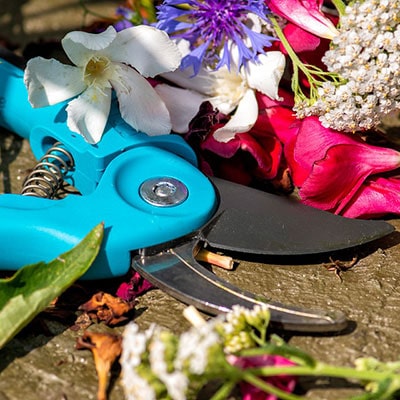
The process of pruning is important to the health and growth of garden plants. When the process is carried out properly it improves the vigour of the plants, stimulates the growth of the plants, and makes the shape of the plants much nicer. Proper pruning encourages and enhances the abilities of plants to flower and bear fruit. It takes the right combinations of artistic skill, scientific knowledge, and the proper tools for the pruning process to be safe, healthy, and produce beautiful results. This may sound complicated, but it is not. It simply requires an understanding of when to prune what plants.
In general, fruiting and flowering plants prefer to be pruned during late winter through to early spring when they are dormant. Other plants like spring-blooming shrubs and trees need to be pruned shortly after flowering as they start setting new buds as soon as the old buds have fallen. Pruning these plants shortly after flowering reduces the risk of pruning off the new buds with the old. There are other plants that need to be pruned and deadheaded continually in order to remain vigorous and in flower. Take comfort in knowing that pruning a plant at the wrong time is rarely fatal. The result may be less flowering and less fruit, but, in the long run, the plant will not be harmed. In order to avoid any possible damage to plants follow these few basic guidelines or pruning tips for various categories of plants:
Tools for Pruning
The job of pruning plants is made easier by using the proper tool for the particular pruning job. Four basic types of tools are necessary for keeping plants healthy:
- Hand pruners
- Loppers
- Shearers
- Saws
It is of the utmost importance to keep all these tools sharp and clean. Sharp tools not only makes it easier to prune plants but will reduce the risk of damage to the plants from dull tools. Cleaning tools is necessary because diseases can be spread accidentally across the entire garden. Alcohol and household cleaners are recommended for disinfecting pruning tools.
Pruning Berry Plants and Fruit Trees
Generally speaking, pruning fruiting plants should be done while they are dormant. It is important to take care with fruit trees because setting buds for the upcoming season's crop is a one off chance. Though plants that flower for some ornamental value will still provide some amount of fruit, the lack of proper pruning and tending will result in a steady decline. Pruning should be given high priority when the harvest of tree fruits and berries is the goal.
Pruning Flowering Trees, Shrubs, and Vines
When it comes to when you should prune plants, flowering trees and shrubs can be the most confusing group of plants to work out. The general guideline is to prune plants that flower in the summer and autumn during their dormant season, which is late winter through to early spring. On the other hand, trees and shrubs that flower in the spring should be pruned soon after the fading of their flowers. It is plants like roses, clematis, and hydrangeas that cause the confusion about pruning because some of them flower in the spring, while other types of the same plants flower in the summer or autumn. Some of these plants even flower repeatedly. Before pruning a particular plant, do the research to find out the best time for pruning and tending.
Pruning Evergreens
Evergreen trees are not often thought of when it comes to pruning. Typically, it is not recommended to prune evergreen trees as a way to control their size. This may cause the tree to become distorted. If a smaller evergreen is preferable it may be necessary to replace the current evergreen tree with a dwarf variety. Pruning an evergreen to encourage a fuller tree can be done by well-timed pruning. Whenever possible it is important to do this type of pruning when the tree is young because the process will become more labour intensive as the tree grows larger.
Pruning Perennial Bedding Plants
Speaking of labour intensive pruning, it is the non-woody perennials that may take the most effort. Some people think that planting perennials creates a completely maintenance free garden. This is a false notion because perennial plants, especially the ones that flower, require cutting back entirely either before or after the growing season. Perennials typically need regular pruning, shearing, or deadheading. How and when to prune the various types of perennial plants is something that is learned over time. People who enjoy gardening find this part of the gardening process most pleasurable; learning about the different plants and relaxing in the garden. This type of knowledge also varies from region to region, depending upon the climate and the types of perennial plants that prosper in the various conditions. When it comes to gardening chat online or in the neighbourhood, it is the pruning of perennial plants that consumes much of the conversation.
Although the condition and the type of pruner that is used for any pruning endeavour, this discussion relates the importance of the timing of pruning to create a vibrant and colourful garden. Those new to gardening can take a conservative approach to pruning in their first year or so until they get the hang of the process. If there is still some hesitation, gardeners can contact a landscaper, research information online, or even seek the help of an arborist for issues with trees, especially when needing to prune tall trees.




